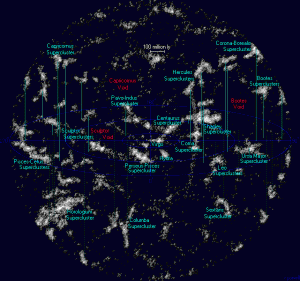Science Seen Physicist and Time One author Colin Gillespie helps you understand your world.
New Light On the Large-Scale Structure of the Universe Rethinking the origin of supermassive black holes
Quadrillions of galaxies make up some structures in the universe. How did such structures arise? How do the galaxies that they are made of grow? As Winston Churchill said of Russia, this is a riddle wrapped in a mystery inside an enigma. Now primordial black holes offer us new hope of an answer.
What is the large-scale structure of the universe? Let’s work our way outwards. Our Sun is one of about a trillion stars in our galaxy, the Milky Way. The Milky Way in turn is one of about one hundred thousand galaxies that form our local supercluster, Laniakea. Its gravity organizes these galaxies into vast streams over hundreds of millions of light years. Laniakea is one of maybe millions of superclusters. They form vast sheets and long filaments that have great voids between them. The image shows about one-hundred superclusters within a billion light years of us. How this mind-bending structure could have taken shape from formless gas is the subject of much study.
One thing is clear: Galaxies are the building blocks of large-scale structure in the universe. How galaxies themselves came into existence soon after the beginning of the universe is yet another mystery. There are theories, backed by supercomputer simulations, but the timelines just don’t seem right.
Let’s start with stars. Current astrophysics theory (supported by computer modeling) shows clumps of gas forming as gravity magnified random patches of the Big Bang hydrogen. Proto-stars coalesce and grow within the clumps. This is a complex process. It starts slowly, because the gas is diffuse, and it soon tends to be self-limiting as in-falling gas releases energy. It gets so hot its intense radiation tends to blow the gas away. So gravity and radiation battle for supremacy. Eventually gravity may win and a star is born. In theory this happened within a few-hundred-million years after the Big Bang.
Astrophysicists need even longer times to build black holes because they start with stars. The first stars had masses of maybe one-hundred times our Sun’s mass M⊙. They got so hot they soon ran through their nuclear fuel. As they then cooled, they could collapse under their own gravity in a supernova explosion. The remnants often formed black holes with masses several times M⊙. Thus the universe needed more millions of years to make such ‘small’ black holes.
To get to galaxies, astrophysics needs far larger black holes, with masses of millions or billions of times M⊙. Such supermassive black holes play a key role in galaxy formation. Recent studies show that at the center of each galaxy there is a big black hole of which the mass is usually a bit more than one-tenth of one percent of the total mass of the galactic central bulge. But where did that giant black hole come from? Astronomer Joseph Hennawi and three colleagues say:
‘Cosmologists do not fully understand the origin of supermassive black holes at the centers of galaxies and how they relate to the evolution of the underlying dark matter, which forms the backbone for the structure of the universe.’
Masterly understatement! Cosmologists don’t know what that underlying dark matter could be. But last week we saw how dark matter may be made of primordial black holes. What a simple explanation! Now let’s see what those same primordial black holes can do for the large-scale-structure problem.
The problem is that we can see big black holes in galaxies when the universe was only seven hundred million years old. Just two billion years after the universe began there was a giant black hole that held some seven billion times M⊙. To make matters worse this was more than one-tenth of the total mass of its galaxy. Today’s physics can’t explain how black holes became so big so soon.
Enter the primordial black holes. In 1974 Bernard Carr and Stephen Hawking proposed that many primordial black holes could have come into existence just moments after the Big Bang. Indeed, right after the beginning, conditions may have been even more favorable for creating black holes than Hawking imagined. By their nature black holes are mass organizers. If black holes were there from the beginning, astrophysics theory would need to reconsider all the processes for making galaxies and filaments and voids.
We can already say that if the universe spawned black holes in a fraction of a second instead of needing most of a billion years it should be much easier to match the theory with our observations.
Perhaps the most interesting aspect is the way philosophy of Planck-scale physics—the tiniest of tiny—can help explain the large-scale structure of the universe.
Sources:
Joseph Hennawi et al. (2015), “Quasar quartet embedded in giant nebula reveals rare massive structure in distant universe”, Science, Washington: AAAS, vol. 348, p. 779;
Other Materials:
Elizabeth Gibney (2014), “Earth’s new address: ‘Solar System, Milky Way, Laniakea’”, Nature, News, Sep. 3, http://www.nature.com/news/earth-s-new-address-solar-system-milky-way-laniakea-1.15819
“Laniakea: Our home supercluster”, Nature Video, https://www.youtube.com/watch?v=rENyyRwxpHo
Image credit: Atlas of the Universe, http://www.atlasoftheuniverse.com/superc.html


No comments yet.